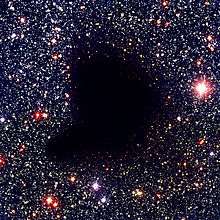Barnard 68
Barnard 68 is a molecular cloud, dark absorption nebula or Bok globule, towards the southern constellation Ophiuchus and well within our own galaxy at a distance of about 400 light-years, so close that not a single star can be seen between it and the Sun. American astronomer Edward Emerson Barnard added this nebula to his catalog of dark nebulae in 1919. His catalog was published in 1927, at which stage it included some 350 objects. Because of its opacity, its interior is extremely cold, its temperature being about 16 K (−257 °C). Its mass is about twice that of the Sun and it measures about half a light-year across.[2]
| Molecular cloud | |
|---|---|
| Bok globule | |
| dark nebula | |
 | |
| Observation data: J2000.0[1] epoch | |
| Right ascension | 17h 22m 38.2s[1] |
| Declination | −23° 49′ 34″[1] |
| Distance | 500[2] ly |
| Constellation | Ophiuchus [2] |
| Physical characteristics | |
| Radius | 0.25[2] ly |
| Designations | Barnard 68, LDN 57 |
Characteristics
Despite being opaque at visible-light wavelengths, use of the Very Large Telescope at Cerro Paranal has revealed the presence of about 3,700 blocked background Milky Way stars, some 1,000 of which are visible at infrared wavelengths.[3] Careful measurements of the degree of obscuration resulted in a finely sampled and accurate mapping of the dust distribution inside the cloud.[4][5] Observations obtained with Herschel Space Observatory were able to constrain the distribution of the dust component and its temperature even more.[6] Having a dark cloud in the solar neighborhood greatly facilitates observation and measurement. If not disrupted by external forces, the stability of dust clouds is a fine balance between outward pressure caused by the heat or pressure of the cloud's contents, and inward gravitational forces generated by the same particles (see Jeans instability and Bonnor-Ebert mass). This causes the cloud to wobble or oscillate in a manner not unlike that of a large soap bubble or a water-filled balloon which is jiggled. In order for the cloud to become a star, gravity must gain the upper hand long enough to cause the collapse of the cloud and reach a temperature and density where fusion can be sustained. When this happens, the much smaller size of the star's envelope signals a new balance between greatly increased gravity and radiation pressure.[7]
The cloud's mass is about twice that of the Sun, and it measures about half a light-year across.[2] Barnard 68's well-defined edges and other features show that it is on the verge of gravitational collapse followed by becoming a star within the next 200,000 years or so.[8]
The cloud is often confused with Boötes void although the two have nothing in common, but pictures of Barnard 68 are often used to illustrate articles about Boötes void.
References
- "LDN 57". SIMBAD. Centre de données astronomiques de Strasbourg. Retrieved 2009-03-01.
- "Astronomy Picture of the Day - 11 May 1999 - Barnard 68". NASA. 1999-05-11. Archived from the original on 11 April 2009. Retrieved 2009-03-01.
- "The Dark Cloud B68 at Different Wavelengths". European Southern Observatory. Retrieved January 30, 2012.
- Alves, João; Lada, Charles; Lada, Elizabeth (March 2001). "Seeing the light through the dark" (PDF). The Messenger. 103: 15–20. Bibcode:2001Msngr.103....1A.
- Alves, João F.; Lada, Charles J.; Lada, Elizabeth A. (January 2001). "Internal structure of a cold dark molecular cloud inferred from the extinction of background starlight". Nature. 409 (6817): 159–161. Bibcode:2001Natur.409..159A. doi:10.1038/35051509. PMID 11196632.
- Nielbock, Markus; Launhardt, Ralf; Steinacker, Jürgen; et al. (August 2012). "The Earliest Phases of Star formation observed with Herschel (EPoS): The dust temperature and density distributions of B68". Astronomy and Astrophysics. 547: A11. arXiv:1208.4512. Bibcode:2012A&A...547A..11N. doi:10.1051/0004-6361/201219139.
- Redman, Matt P.; Keto, Eric; Rawlings, J. M. C. (July 2006). "Oscillations in the stable starless core Barnard". Monthly Notices of the Royal Astronomical Society. 370 (1): L1–L5. arXiv:astro-ph/0604056. Bibcode:2006MNRAS.370L...1R. doi:10.1111/j.1745-3933.2006.00172.x.
- Burkert, Andreas; Alves, João (2009). "THE INEVITABLE FUTURE OF THE STARLESS CORE BARNARD 68". The Astrophysical Journal. 695 (2): 1308–1314. arXiv:0809.1457. Bibcode:2009ApJ...695.1308B. doi:10.1088/0004-637X/695/2/1308. ISSN 0004-637X.
External links
| Wikimedia Commons has media related to Barnard 68. |
- The Black Cloud - Ken Croswell
- C18O abundance in the nearby globule Barnard 68
- ESO, How to Become a Star - ESO Telescopes Provide Most Detailed View Ever Into a Dark Cloud, 10 January 2001 (accessed 1 March 2009)
- New Scientist, Astrophile: Lucky strike turns a dark cloud into a star, 6 September 2012